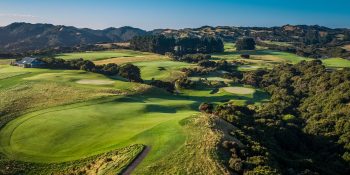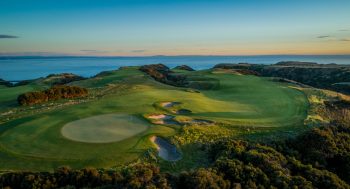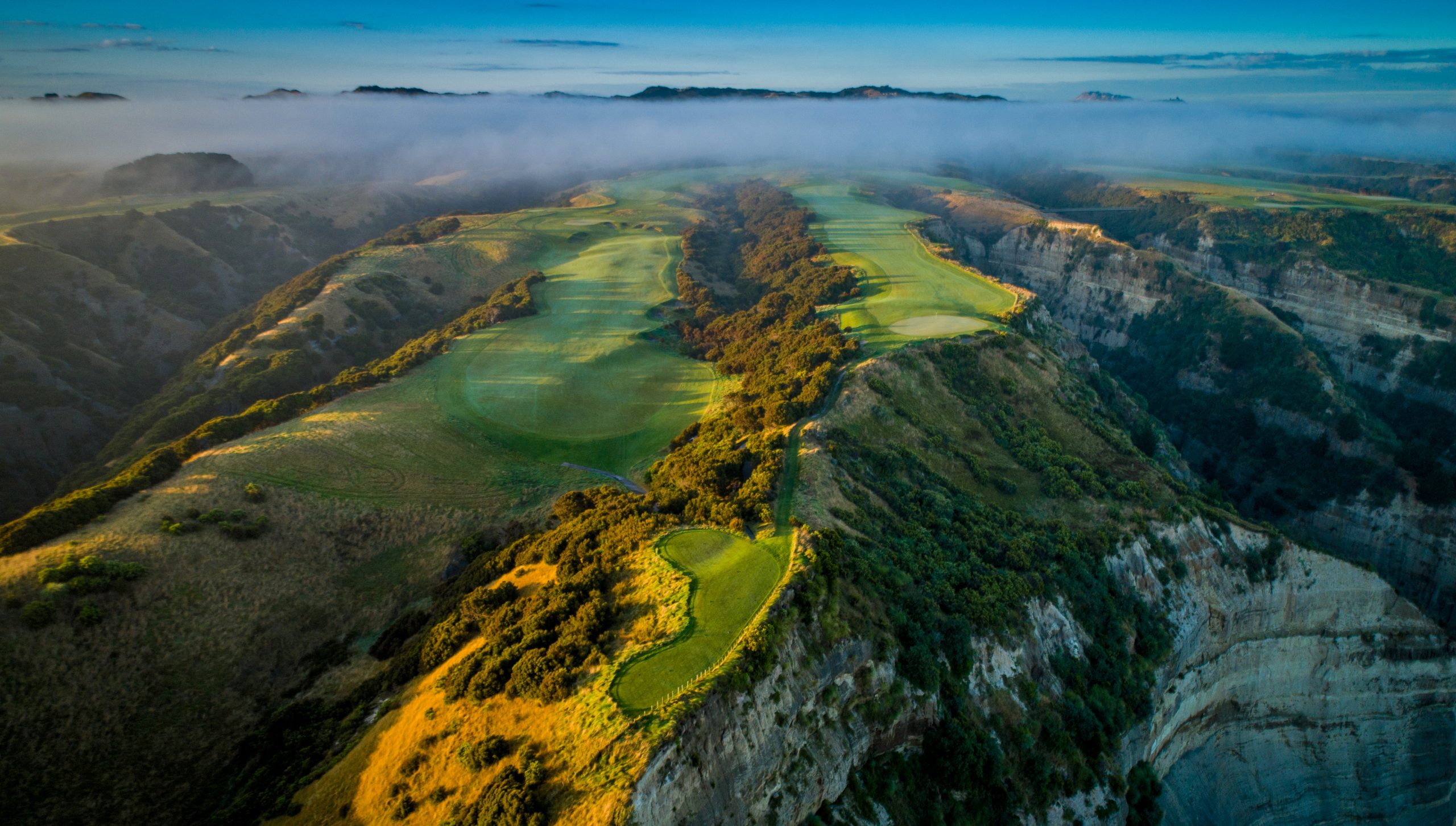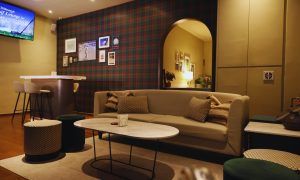
Aerial images of the 7th, 8th and 9th. Photo: Nick Wall/AirSwing
Cape Kidnappers GC, the perennial world-top-50 course designed by Tom Doak, prepared for its 20th anniversary as any elite golf property might: It renovated, under Doak’s direction, then it charged photographers with recapturing anew one of the most scenic, strategic layouts on Earth.
The 18 holes at Cape Kidnappers have never looked or played better. Yet Doak himself believes his first Kiwi design — which, in 2011, rose as high as #38 in the world (today it ranks #51) — remains oddly misunderstood.
“There is nothing quite like it in golf; it just sits so high above the water,” Doak explains. “This is a course fairly ranked among the top 50 in the world, but I’ve found people have difficulty classifying Cape Kidnappers in their own minds — because it’s so different and distinct from anything else.
“This is interesting to me, and I come at it from a pretty fair perspective, I think: Some argue, Oh, Cape Kidnappers is not a links. I understand what they’re saying. But whenever you talk about a world-class links, you have to compare it to Dornoch and all the great links on Earth. But when you look around and hold Cape up to the same kind of scrutiny, there is nothing comparable in terms of setting and scale. It really does stand alone and may always stand alone.“
Opened for play in 2004, Cape Kidnappers GC immediately staked its claim as one of golf’s modern architectural and scenic marvels. Much of the back nine strategically flirts with sheer, white cliffs that drop 150 meters down into Hawkes Bay. Others flank deep, thickly vegetated ravines that, anywhere else, would represent a course’s most memorable physical features.
According to Director of Golf Ray Geffre, first-time visitors to Cape Kidnappers are often surprised by the breadth of amazing golf and terrain away from the cliff edges, not just canyons but the exotic vegetation and striking elevation changes in the form of massive, natural swales and hillocks. This stunning terrain, the deep dramatic bunkering and some of Doak’s finest green settings all produce a collection of inland holes with few peers — holes that better recall the heathland style of course architecture, rather than links.
Geffre believes Cape’s own photography from 2011 — specifically, a handful of aerial images featuring fingers of fairway, running back and forth from the cliff tops above Hawkes Bay — have curiously served to underexpose what makes the entire routing at Cape Kidnappers so extraordinary.
“We hear this all the time: People are sort of amazed at how different it feels to play the golf course — and to see all these vistas and birds and ravines and amazing landforms,” Geffre says. “It’s probably because their only impressions of Cape Kidnappers, until they arrive, were those aerial photos looking straight down at holes 15 and 16.”
Doak can sympathise with their shock, but only to a point: “Of course it looks different in person — because you’re not a bird!”
With the renovation work completed, Geffre commissioned two separate photographers to shoot Cape Kidnappers anew — stills and video footage. Australian Nick Wall of AirSwing and NZ-based photographer Rickey Robinson each produced dozens compelling new takes on the famous cliff holes. But they also shined a long-deferred light on some of the finest inland holes anywhere in golf.
Ownership was also determined to restore the firm and fast turf conditions that Doak first created — because bounce & roll are vital to the strategic function of links designs, heathland deigns and one-of-a-kind hybrids like Cape Kidnappers. Working with Doak and ace shaper Angela Moser, course superintendent Brad Sim oversaw the regrassing of all 18 fairways, in addition the rebuilding and regrassing all 18 greens.
“We rebuilt the putting surfaces from 10 inches down and Angela put the contours back exactly as they’d been before,” says Geffre, who also looks after golf operations Kauri Cliffs GC, located 500 kilometres to the north and a world-top-100 golf course in its own right.

The 17th fairway and green. Photo: Nick Wall/AirSwing
“Regrassing the greens at Cape and addressing our thatch problem was pretty straightforward. But the fairways were a huge undertaking — just an enormous volume of turf for an in-house crew to peel back and replant. And oh by the way, that entire project was undertaken and completed under Covid conditions. My hat’s off to Brad and his crews. They did an amazing job.
“The renovation also substantially upped our game on the practice-facility front. We expanded our range and built brand new putting and chipping greens. We also embarked on some strategic tree clearing, and we’re determined to keep that going. This is an incredibly diverse and lush eco-system, and I doubt there’s another resort on earth that takes environmental protections more seriously than we do. But we need to protect our vistas, too, and preserve the original design here. For a while there, we had manuka creeping into the bunker and blocking the view of 4 green. The kanuka and manuka we trimmed back all along the right side of 15: Those are meant to be plants — they were head high!”
The natural setting at Cape Kidnappers is part of what makes the course one-of-a-kind. The entire peninsula extends 10 kilometres from the south-eastern extremity of Hawkes Bay into the South Pacific. The golf course and adjacent lodge, The Farm at Cape Kidnappers, occupy a 6,000-acre property protected by more than 10 kilometres of protective fencing — meaning the barrier extends nearly as far below ground as above it, to protect endangered species from predators.
As a result, golfers are treated to fauna and flora unlike any in the world. Guests at The Farm can partake of Kiwi Discovery walks, Hanging Rock Gorge hikes and all manner of bird tours — the tip of Cape Kidnappers is home to the world’s largest gannet colony. These examples of naturalistic sights and activities only scratch the surface: The Cape Sanctuary is the largest privately owned and funded wildlife restoration project of its kind in New Zealand.
Located just 20 km from the seaside, art deco community of Napier, Cape Kidnappers GC resides in the heart of New Zealand’s wine country, further complementing a mighty rich resort tableau — completely apart from the accommodations. Yet it just so happens that The Farm at Cape Kidnappers, a Relais & Châteaux affiliate, ranks among the finest boutique hotels in captivity. Doak, for one, is a fan: “It’s the nicest lodge in the country. Maybe on Earth.”








